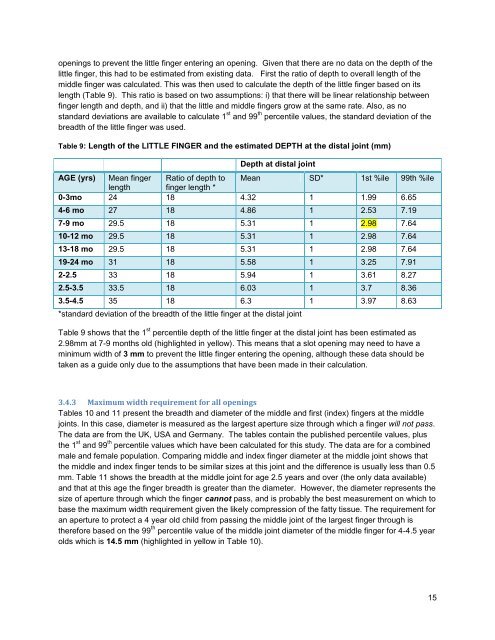Requirements for finger entrapment in European safety ... - ANEC
Requirements for finger entrapment in European safety ... - ANEC
Requirements for finger entrapment in European safety ... - ANEC
Create successful ePaper yourself
Turn your PDF publications into a flip-book with our unique Google optimized e-Paper software.
open<strong>in</strong>gs to prevent the little <strong>f<strong>in</strong>ger</strong> enter<strong>in</strong>g an open<strong>in</strong>g. Given that there are no data on the depth of the<br />
little <strong>f<strong>in</strong>ger</strong>, this had to be estimated from exist<strong>in</strong>g data. First the ratio of depth to overall length of the<br />
middle <strong>f<strong>in</strong>ger</strong> was calculated. This was then used to calculate the depth of the little <strong>f<strong>in</strong>ger</strong> based on its<br />
length (Table 9). This ratio is based on two assumptions: i) that there will be l<strong>in</strong>ear relationship between<br />
<strong>f<strong>in</strong>ger</strong> length and depth, and ii) that the little and middle <strong>f<strong>in</strong>ger</strong>s grow at the same rate. Also, as no<br />
standard deviations are available to calculate 1 st and 99 th percentile values, the standard deviation of the<br />
breadth of the little <strong>f<strong>in</strong>ger</strong> was used.<br />
Table 9: Length of the LITTLE FINGER and the estimated DEPTH at the distal jo<strong>in</strong>t (mm)<br />
Depth at distal jo<strong>in</strong>t<br />
AGE (yrs) Mean <strong>f<strong>in</strong>ger</strong> Ratio of depth to Mean SD* 1st %ile 99th %ile<br />
length <strong>f<strong>in</strong>ger</strong> length *<br />
0-3mo 24 18 4.32 1 1.99 6.65<br />
4-6 mo 27 18 4.86 1 2.53 7.19<br />
7-9 mo 29.5 18 5.31 1 2.98 7.64<br />
10-12 mo 29.5 18 5.31 1 2.98 7.64<br />
13-18 mo 29.5 18 5.31 1 2.98 7.64<br />
19-24 mo 31 18 5.58 1 3.25 7.91<br />
2-2.5 33 18 5.94 1 3.61 8.27<br />
2.5-3.5 33.5 18 6.03 1 3.7 8.36<br />
3.5-4.5 35 18 6.3 1 3.97 8.63<br />
*standard deviation of the breadth of the little <strong>f<strong>in</strong>ger</strong> at the distal jo<strong>in</strong>t<br />
Table 9 shows that the 1 st percentile depth of the little <strong>f<strong>in</strong>ger</strong> at the distal jo<strong>in</strong>t has been estimated as<br />
2.98mm at 7-9 months old (highlighted <strong>in</strong> yellow). This means that a slot open<strong>in</strong>g may need to have a<br />
m<strong>in</strong>imum width of 3 mm to prevent the little <strong>f<strong>in</strong>ger</strong> enter<strong>in</strong>g the open<strong>in</strong>g, although these data should be<br />
taken as a guide only due to the assumptions that have been made <strong>in</strong> their calculation.<br />
3.4.3 Maximum width requirement <strong>for</strong> all open<strong>in</strong>gs<br />
Tables 10 and 11 present the breadth and diameter of the middle and first (<strong>in</strong>dex) <strong>f<strong>in</strong>ger</strong>s at the middle<br />
jo<strong>in</strong>ts. In this case, diameter is measured as the largest aperture size through which a <strong>f<strong>in</strong>ger</strong> will not pass.<br />
The data are from the UK, USA and Germany. The tables conta<strong>in</strong> the published percentile values, plus<br />
the 1 st and 99 th percentile values which have been calculated <strong>for</strong> this study. The data are <strong>for</strong> a comb<strong>in</strong>ed<br />
male and female population. Compar<strong>in</strong>g middle and <strong>in</strong>dex <strong>f<strong>in</strong>ger</strong> diameter at the middle jo<strong>in</strong>t shows that<br />
the middle and <strong>in</strong>dex <strong>f<strong>in</strong>ger</strong> tends to be similar sizes at this jo<strong>in</strong>t and the difference is usually less than 0.5<br />
mm. Table 11 shows the breadth at the middle jo<strong>in</strong>t <strong>for</strong> age 2.5 years and over (the only data available)<br />
and that at this age the <strong>f<strong>in</strong>ger</strong> breadth is greater than the diameter. However, the diameter represents the<br />
size of aperture through which the <strong>f<strong>in</strong>ger</strong> cannot pass, and is probably the best measurement on which to<br />
base the maximum width requirement given the likely compression of the fatty tissue. The requirement <strong>for</strong><br />
an aperture to protect a 4 year old child from pass<strong>in</strong>g the middle jo<strong>in</strong>t of the largest <strong>f<strong>in</strong>ger</strong> through is<br />
there<strong>for</strong>e based on the 99 th percentile value of the middle jo<strong>in</strong>t diameter of the middle <strong>f<strong>in</strong>ger</strong> <strong>for</strong> 4-4.5 year<br />
olds which is 14.5 mm (highlighted <strong>in</strong> yellow <strong>in</strong> Table 10).<br />
15
















